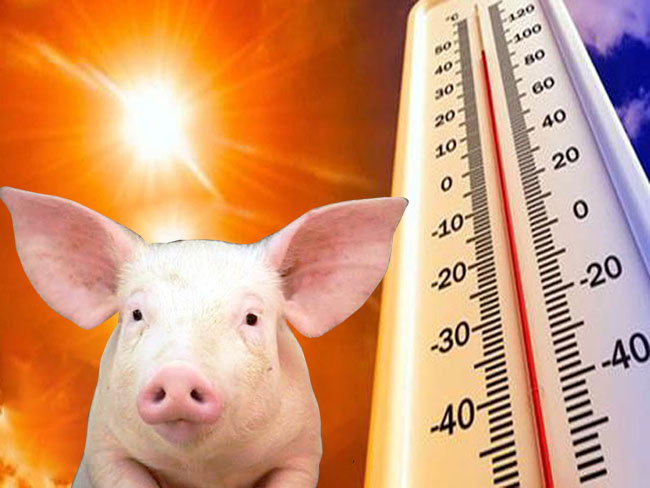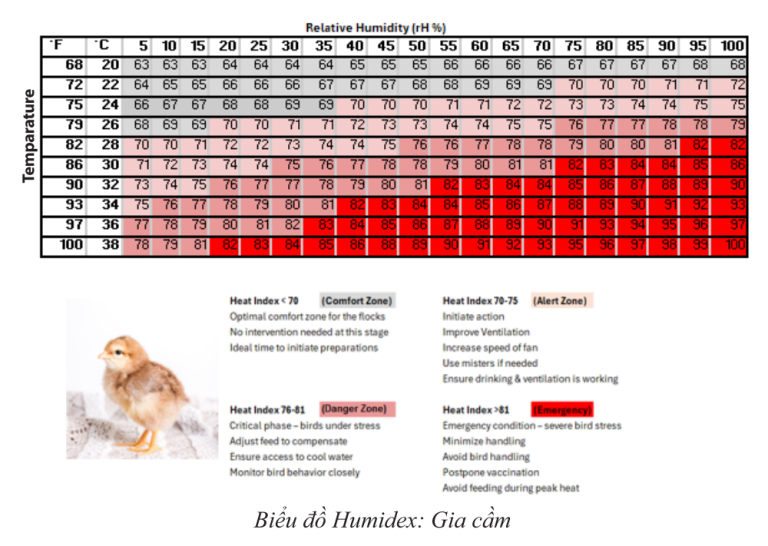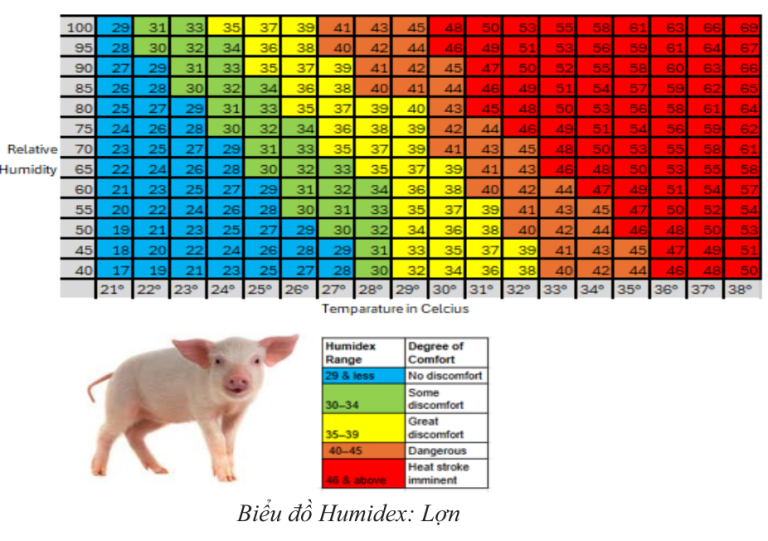
press release
Heat and humidity stress in poultry and pig farming
[Vietnam Livestock] – As global temperatures rise, the livestock industry faces growing challenges in maintaining the health and productivity of livestock. One of the most serious concerns today is heat stress, especially when exacerbated by high humidity. Poultry and pigs are particularly vulnerable species, with health, behavior and performance significantly affected under such conditions.
Understand heat stress and the role of humidity
Heat stress occurs when pets cannot effectively release excess heat in the body, disrupting the ability to maintain stable body temperature. Although high ambient temperatures are the main cause, high humidity makes the condition more severe than ice, hindering evaporative cooling mechanisms such as shortness of breath or sweat.
To better understand the combined effects of heat and humidity, especially on poultry and pigs, the Temperature – Humidity Index (THI – Temperature – Humidity Index) is widely used as a real-world index that reflects the level heat stress. THI combines ambient temperature and relative humidity into a single indicator, reflecting the level of hot“that pets actually feel.
Consequences of heat stress in poultry and the role of amplification of warmth
Heat stress in poultry is a serious problem, occurring when the body’s core temperature exceeds the normal threshold, usually ranging from 39.5-41°C depending on age. If body temperature exceeds 41°C, it can cause extensive cell damage, systemic inflammation, circulatory shock and ultimately death. Understanding the individual and combined effects of high temperatures and high humidity on poultry health is essential to prevent damage and ensure animal welfare.
Effects of heat stress on poultry even in low humidity conditions
Unlike mammals, poultry do not have sweat glands and are primarily dependent on inhalation cooling (steep breathing) mechanisms to regulate body temperature. This makes them particularly vulnerable in high temperature environments. Even in dry conditions, when the ambient temperature approaches or exceeds the body temperature of poultry (39.5-41°C), their ability to radiate heat is seriously impaired. At this threshold, convective cooling (wind flow) is no longer effective and shortness of breath becomes the only mechanism, significantly increasing the risk of heat stress and death.
Humidity worsens heat stress: Thermosensitive index
Humidity increases the effect of temperature: As a rule, for every 10% increase in humidity, the heat sensation that the cam feels will increase by about 2°C. For example, a temperature of 30°C in a dry desert would be much more pleasant than 30°C in a humid jungle environment.
Thermosensitive index and mortality rate: The thermosensitive index calculator helps estimate the “sensory temperature the bird actually experiences. For example, at 34°C and 40% humidity, the perceived temperature is around 35°C. However, if humidity increases to 65%, the thermosensitive index can skyrocket to 44°C, sharply increasing the risk of death.
Cellular and physiological damage
High temperature cell damage: When poultry body temperature exceeds 41°C, it will trigger cell damage and systemic inflammation, quickly leading to circulatory shock and death. In the long term, it can cause bowel problems such as leaky gut syndrome.
Impaired productivity and immunity: Chronic heat stress weakens the immune system, reduces voluntary food intake, reduces digestive efficiency and nutrient absorption, and reduces growth rate, egg production and fertility.
Impact of heat stress and humidity on meat poultry, laying hens and breeding chickens
Broilers
High thermal load due to rapid growth: Chicken broiler is selected for rapid growth and high efficiency, generating large metabolic heat. This makes them susceptible to heat stress, especially in hot and humid conditions, where heat release becomes difficult.
Reduced breathing cooling efficiency: Under high humidity conditions, shortness of breath becomes ineffective, leading to increased body temperature, reduced welfare and affecting meat quality.
Reduced feed intake and meat production: Heat stress reduces voluntary feed intake, with consequent reduction in growth and end-of-period weight, reducing economic efficiency.
Reduced food metabolism and muscle growth: Even a slight increase in temperature and humidity reduces the rate of food metabolism (FCR) due to energy being transferred from development to body temperature regulation, affecting affects muscle development and meat appearance.
Increased mortality: When high temperatures are combined with high humidity, the risk of death increases because the body is no longer able to regulate heat, which is especially dangerous in high-density farming models.
Intestinal damage and increased risk of disease: Heat stress increases intestinal permeability and inflammation, making chickens susceptible to pathogenic bacteria such as Clostridium perfringens, leading to necrotizing enteritis, which reduces nutritional absorption and meat production.
Layers
Reduced feeding and nutritional deficiencies: Heat and moisture reduce voluntary feeding, causing energy ice and calcium imbalance, affecting egg production, egg production and eggshell quality.
Thin eggshells and COz disorders: Calcium and CO deficiency, high in poorly ventilated cages changes blood pH, disorders in calcium metabolism, affects shell glands and produces eggs of poor commercial quality.
Endocrine and immune disorders: Heat stress increases corticosterone, causes immunosuppression and reproductive hormone disorders, leading to reduced time to restrain egg production and increased risk of disease.
Breeders
Reduced quality of eggs and embryos: Extended high heat and moisture thin the shell, reduce lunar quality and fertilization rate, leading to reduced hatching and increased premature embryo death.
Reduced reproductive efficiency: Heat stress reduces sperm quality in roosters (concentration, mobility) and ovulation disorders and yolk laceration in hens → reduces fertilization rate and chicks quality.
Systemic physiological stress: Prolonged heat and moisture cause oxidative stress, electrolyte disorders, endocrine ice imbalance, reduce reproductive lifespan, resistance and production efficiency, requiring nutritional intervention and specialized environment.
Effects of heat stress and humidity on pigs
Pigs are particularly sensitive to heat stress due to poor cooling and lack of functional sweat glands. Pigs primarily regulate their body temperature through behavior such as lying in mud, finding cool places, and reducing physical contact. However, these behaviors are limited in intensive livestock systems, increasing heat load and pathological risk.
Humidity plays a key role in amplifying stress. High humidity reduces the ability to release heat, especially when pigs try to cool down through increased breathing and heat transfer through the skin. In contrast, low humidity with high heat can easily cause severe dehydration, increased respiratory exertion and systemic pressure.
• Increased breathing rate and reduced food intake under heat stress conditions impair growth and metabolic efficiency.
• Increased water/food unit ratio and lethargy are signs that the heat burden is progressing.
• Reduced milk production in lactating sows seriously affects the growth and survival of piglets.
• Slow weaning and poor reproductive performance in sows subjected to prolonged heat stress.
• Behavioral signs include five tilts, dirtying the cage, limiting the behavior of lying in mud for cooling.
• Carcass quality declines markedly due to heat stress.
• Mortality rates can be elevated in extreme temperature and humidity conditions.
Prevention strategies
Managing heat and humidity stress is a critical challenge for poultry and pig farmers, as these environmental factors can seriously impair animal health, reduce productivity and increase the risk of disease outbreak.
Phytocee – is a herbal additive in Animal Feed, formulated with a special mixture of plant active ingredients (phytoactives) such as polyphenols, withanolides and triterpenoids that act on a variety of mechanisms, helping to enhance the animal’s tolerance to adverse conditions.
As an adaptogen (adaptive regulator), Phytocee supports the balance of animal metabolism and physiology when exposed to high temperatures and humidity, helping the body adapt and stabilize itself.
Strong antioxidant activity helps neutralize free radicals that arise during heat stress, protects cells and tissues, promotes faster recovery and minimizes long-term health effects.
At the same time, Phytocee is also an immunomodulator, enhancing natural and adaptive immunity, which is important when pets are exposed to heat stress, which inhibits immunity and increases the risk of infection.
Comprehensive and sustainable solutions
Overall, Phytocee provides a comprehensive prevention strategy, helping poultry and pigs maintain optimal performance, health and well-being in high temperature and humidity conditions. As a natural solution from herbs, the product not only solves core production challenges but also supports a safe and sustainable livestock orientation, meeting the increasing demand for food safety and environmental protection.
Natural Remedies – Pioneer in pet health care
Natural Remedies is a pioneer in animal health care, with more than 30 years of industry experience. The company is headquartered in India and has expanded its global presence in more than 45 countries.
Natural Remedies focuses on developing a herbal (phytogenic) alternative to the safe, effective and reliable – chemical product, putting pet health and sustainability first.
Core Values “Useful” (Being Useful) is the guideline for the company’s mission – to create positive impacts for the environment and society, towards a better world for current generations and future.





Add your comment